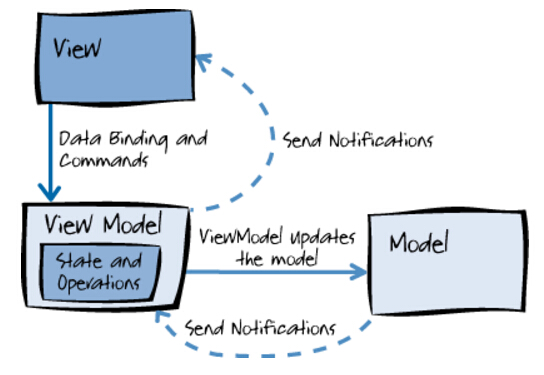学习WPF和MVVM一段时间的总结
WPF的MVVM设计模式
从winform转变到WPF的过程,难点主要还是在MVVM的设计模式。当然,如果依然采用winform的涉及方式,在每个控件背后绑定事件的方式运用在wpf中,依然可行,但是假如GUI改版,其背后绑定的特别为此界面设计的事件不得不多数弃用。而MVVM最大的好处是将一切业务逻辑放在ViewModel中 ,将GUI的操作放在view中,将数据结构放在Model中,如图摘自MSDN

实际使用
使用了Prism框架,省去了去构造实现INotifyPropertyChanged的基类,直接继承BindableBase
namespace Prism.Mvvm
{
//
// 摘要:
// Implementation of System.ComponentModel.INotifyPropertyChanged to simplify models.
public abstract class BindableBase : INotifyPropertyChanged
{
protected BindableBase();
//
// 摘要:
// Occurs when a property value changes.
public event PropertyChangedEventHandler PropertyChanged;
//
// 摘要:
// Notifies listeners that a property value has changed.
//
// 参数:
// propertyName:
// Name of the property used to notify listeners. This value is optional and can
// be provided automatically when invoked from compilers that support System.Runtime.CompilerServices.CallerMemberNameAttribute.
protected virtual void OnPropertyChanged([CallerMemberName] string propertyName = null);
//
// 摘要:
// Raises this object's PropertyChanged event.
//
// 参数:
// propertyExpression:
// A Lambda expression representing the property that has a new value.
//
// 类型参数:
// T:
// The type of the property that has a new value
protected virtual void OnPropertyChanged<T>(Expression<Func<T>> propertyExpression);
//
// 摘要:
// Checks if a property already matches a desired value. Sets the property and notifies
// listeners only when necessary.
//
// 参数:
// storage:
// Reference to a property with both getter and setter.
//
// value:
// Desired value for the property.
//
// propertyName:
// Name of the property used to notify listeners. This value is optional and can
// be provided automatically when invoked from compilers that support CallerMemberName.
//
// 类型参数:
// T:
// Type of the property.
//
// 返回结果:
// True if the value was changed, false if the existing value matched the desired
// value.
protected virtual bool SetProperty<T>(ref T storage, T value, [CallerMemberName] string propertyName = null);
}
以及用来构造Command的基类DelegateCommand
namespace Prism.Commands
{
//
// 摘要:
// An System.Windows.Input.ICommand whose delegates do not take any parameters for
// Prism.Commands.DelegateCommand.Execute and Prism.Commands.DelegateCommand.CanExecute.
public class DelegateCommand : DelegateCommandBase
{
//
// 摘要:
// Creates a new instance of Prism.Commands.DelegateCommand with the System.Action
// to invoke on execution.
//
// 参数:
// executeMethod:
// The System.Action to invoke when System.Windows.Input.ICommand.Execute(System.Object)
// is called.
public DelegateCommand(Action executeMethod);
//
// 摘要:
// Creates a new instance of Prism.Commands.DelegateCommand with the System.Action
// to invoke on execution and a Func to query for determining if the command can
// execute.
//
// 参数:
// executeMethod:
// The System.Action to invoke when System.Windows.Input.ICommand.Execute(System.Object)
// is called.
//
// canExecuteMethod:
// The System.Func`1 to invoke when System.Windows.Input.ICommand.CanExecute(System.Object)
// is called
public DelegateCommand(Action executeMethod, Func<bool> canExecuteMethod);
protected DelegateCommand(Func<Task> executeMethod);
protected DelegateCommand(Func<Task> executeMethod, Func<bool> canExecuteMethod);
//
// 摘要:
// Factory method to create a new instance of Prism.Commands.DelegateCommand from
// an awaitable handler method.
//
// 参数:
// executeMethod:
// Delegate to execute when Execute is called on the command.
//
// 返回结果:
// Constructed instance of Prism.Commands.DelegateCommand
public static DelegateCommand FromAsyncHandler(Func<Task> executeMethod);
//
// 摘要:
// Factory method to create a new instance of Prism.Commands.DelegateCommand from
// an awaitable handler method.
//
// 参数:
// executeMethod:
// Delegate to execute when Execute is called on the command. This can be null to
// just hook up a CanExecute delegate.
//
// canExecuteMethod:
// Delegate to execute when CanExecute is called on the command. This can be null.
//
// 返回结果:
// Constructed instance of Prism.Commands.DelegateCommand
public static DelegateCommand FromAsyncHandler(Func<Task> executeMethod, Func<bool> canExecuteMethod);
//
// 摘要:
// Determines if the command can be executed.
//
// 返回结果:
// Returns true if the command can execute, otherwise returns false.
public virtual bool CanExecute();
//
// 摘要:
// Executes the command.
public virtual Task Execute();
//
// 摘要:
// Observes a property that is used to determine if this command can execute, and
// if it implements INotifyPropertyChanged it will automatically call DelegateCommandBase.RaiseCanExecuteChanged
// on property changed notifications.
//
// 参数:
// canExecuteExpression:
// The property expression. Example: ObservesCanExecute((o) => PropertyName).
//
// 返回结果:
// The current instance of DelegateCommand
public DelegateCommand ObservesCanExecute(Expression<Func<object, bool>> canExecuteExpression);
//
// 摘要:
// Observes a property that implements INotifyPropertyChanged, and automatically
// calls DelegateCommandBase.RaiseCanExecuteChanged on property changed notifications.
//
// 参数:
// propertyExpression:
// The property expression. Example: ObservesProperty(() => PropertyName).
//
// 类型参数:
// T:
// The object type containing the property specified in the expression.
//
// 返回结果:
// The current instance of DelegateCommand
public DelegateCommand ObservesProperty<T>(Expression<Func<T>> propertyExpression);
}
}
第一次使用MVVM设计模式,没有理解在多个ViewModel之间通信,所以不得不采用单一ViewModel和多个view,这样导致了一个ViewModel的臃肿和复杂,看似结构简单,但是实际的逻辑越来越混乱。在没有理解Event Aggregator如何使用的情况下,这是可行方案。
MVVM使用感受
最主要的感受是MVVM将UI和业务逻辑分离,UI就只写UI,不用像WinForm一样在每个事件背后,如果要获得UI某个TextBox的数据,得通过如下获取
public void SomeButton_Clicked(object sender, EventArgs e)
{
string text = textBox1.Text;
DoSomeThings(text);
...
}
同样,后台事件要更新前台UI数据时
pubic void SomeButton_Clicked(object sender, EvnetArgs e)
{
DoOtherThings();
textBox1.Text = "Some Text";
}
这种硬编码的形式,遇到UI的重大变化,必须就将背后事件对应UI的控件名称全部更改才能继续运行。当软件达到一定复杂度,这样做就是灾难性的。
而MVVM,使用了数据绑定,虽然增加了一点代码,但是带来的好处巨大。在ViewModel中先定义要绑定的数据
private string name;
public string Name{
get{return name;}
set{
if (name != value)
{
name = value;
OnPropertyChanged("Name"); // 实现INotifyPropertyChanged接口
}
}
}
然后在view中将其和TextBox数据绑定
<TextBox Text="{Binding Name, Mode=TwoWay}">
这里的数据绑定方式是双向绑定,后台数据变化会自动通知前台UI线程更新数据,相反,前台UI线程更改了数据,后台的数据也会相应变化。这样,在实际数据更新时,不用去查看绑定的UI控件名称,也不用担心在其他线程更新控件数据时要用oneControl.Invoke(Action action)。
总结
第一次使用MVVM感受到的优点:
-
数据绑定,不用考虑具体UI控件的名称,不用手动更新UI数据。
-
UI可操作性更大,支持template
-
业务逻辑和UI分离,界面改版方便
但同样带来了缺点:
-
代码量明显增加
-
对于小软件来说,开发没有WinFrom来的敏捷